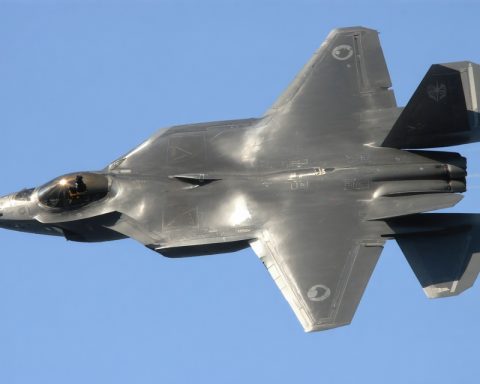In a groundbreaking achievement, the F-35 fighter jet has taken a major leap forward by successfully sharing classified data in-flight with a Command and Control system outside of the United States. This significant milestone was the result of collaboration between Lockheed Martin Skunk Works and the United Kingdom’s Royal Air Force Rapid Capabilities Office.
The operation involved an F-35 launching from Lockheed Martin’s base in Fort Worth, Texas, exchanging critical information with the combat platform Nexus located in Farnborough, UK. This remarkable feat was made possible through Skunk Works’ Open Systems Gateway, which used commercial satellite communications to secure a reliable connection.
A Strategic Leap for Air Power
Termed “Project DEIMOS,” the test was hailed as a monumental advancement by the Royal Air Force. It showcased the F-35’s ability to transmit real-time data directly to the RAF’s Nexus platform, enabling immediate data analysis and enhancing operational readiness.
This success signifies a major advancement in creating a future-integrated battle space and reinforcing Air Command and Control systems. By merging various technologies, allies like the UK and the US are boosting military efficiency and response to global threats, enhancing their defense capabilities.
Revolutionizing Multinational Defense Collaboration
The project highlighted the secure, continuous data transmission across different national systems, a pivotal achievement for multi-domain operations. John Clark from Lockheed Martin emphasized that this exercise marks a watershed in multidomain operations, underscoring the F-35’s capacity to share exclusive data across an open platform with international allies.
Such strategic partnerships and innovations are crucial in rapidly delivering advanced capabilities to address the ever-evolving global defense landscape. The Project DEIMOS showcases the F-35’s crucial role in modern defense strategies, connecting allies and driving technological advancements to effectively tackle contemporary threats.
F-35 Jet Revolutionizes Defense with Advanced Data Connectivity
In the ever-evolving world of defense technology, the F-35 fighter jet has set a new standard by successfully sharing classified data in-flight with a Command and Control system outside of the United States. This groundbreaking achievement was facilitated by a collaboration between Lockheed Martin Skunk Works and the United Kingdom’s Royal Air Force Rapid Capabilities Office.
—
Innovative Communication System: Project DEIMOS
Project DEIMOS, as this test is known, marked a significant milestone. The F-35 took off from Lockheed Martin’s Fort Worth base in Texas and managed to exchange critical information with the RAF’s Nexus platform in Farnborough, UK. This data transfer was enabled through Skunk Works’ Open Systems Gateway, utilizing commercial satellite communications for secure and reliable connectivity.
The seamless real-time data transmission demonstrated the strategic ability of the F-35 to enhance operational readiness by allowing immediate data analysis. This advancement represents a major leap in creating a fully integrated future battle space and bolstering Air Command and Control systems.
—
Strategic Implications and Trends
The success of Project DEIMOS indicates a potential shift in multinational defense strategies. By merging various technologies, allies like the US and UK can improve military efficiency and responsiveness to global threats. This project exemplifies the potential for collaborative innovation, reinforcing defense capabilities through strengthened international connections.
—
Insights into Multinational Defense Collaboration
The continuous, secure data transmission among different national systems underscores the F-35’s pivotal role in modern defense strategies. John Clark from Lockheed Martin described this as a watershed moment for multi-domain operations, showcasing the capability of the F-35 to share classified data with international allies across a secure, open platform.
Such strategic partnerships and innovations are vital in delivering advanced capabilities rapidly, which are essential in addressing the dynamic global defense landscape.
—
Future Predictions and Innovations
This milestone hints at future advancements in integrated defense systems. By streamlining secure communications between allies, the F-35 paves the way for enhanced multinational defense strategies, improving the ability to tackle contemporary threats effectively.
As these technologies continue to evolve, they will likely redefine global military collaboration and operations, leading to more efficient, responsive, and secure defense mechanisms.
For more information on advancements in defense technology, visit Lockheed Martin.
—
Conclusion
The F-35’s successful data transmission marks a defining moment in global defense collaboration. Through strategic innovation and partnerships, the F-35 stands as a testament to the potential of modern military advancements in achieving real-time connectivity and responsiveness in complex defense environments.











